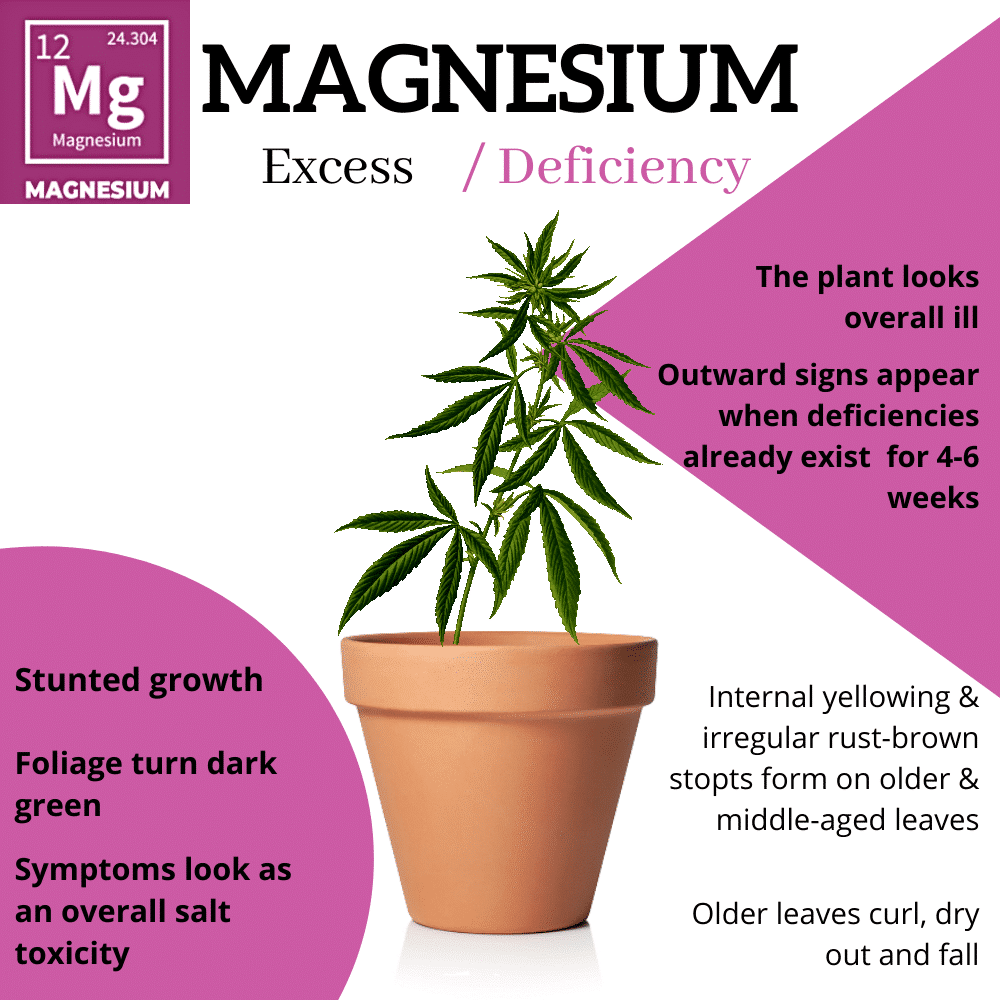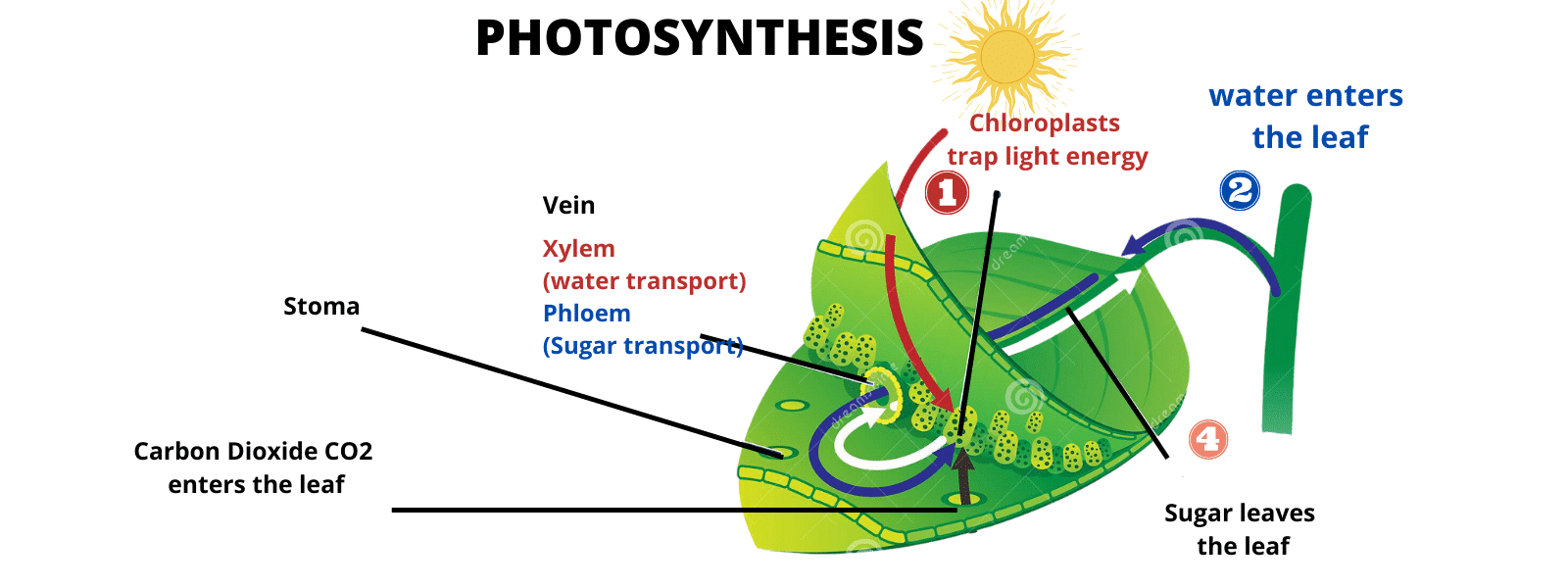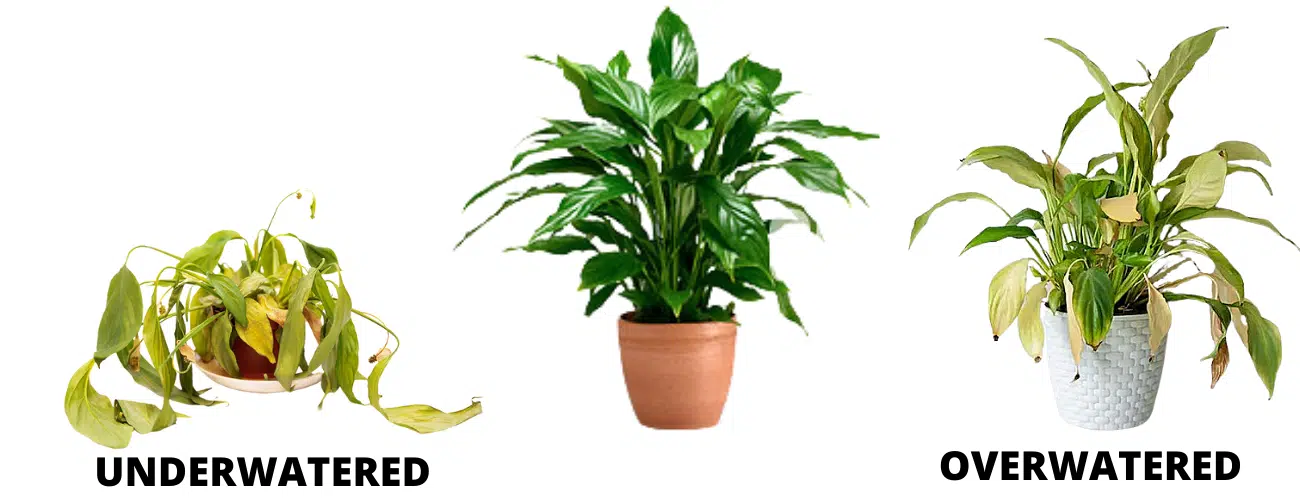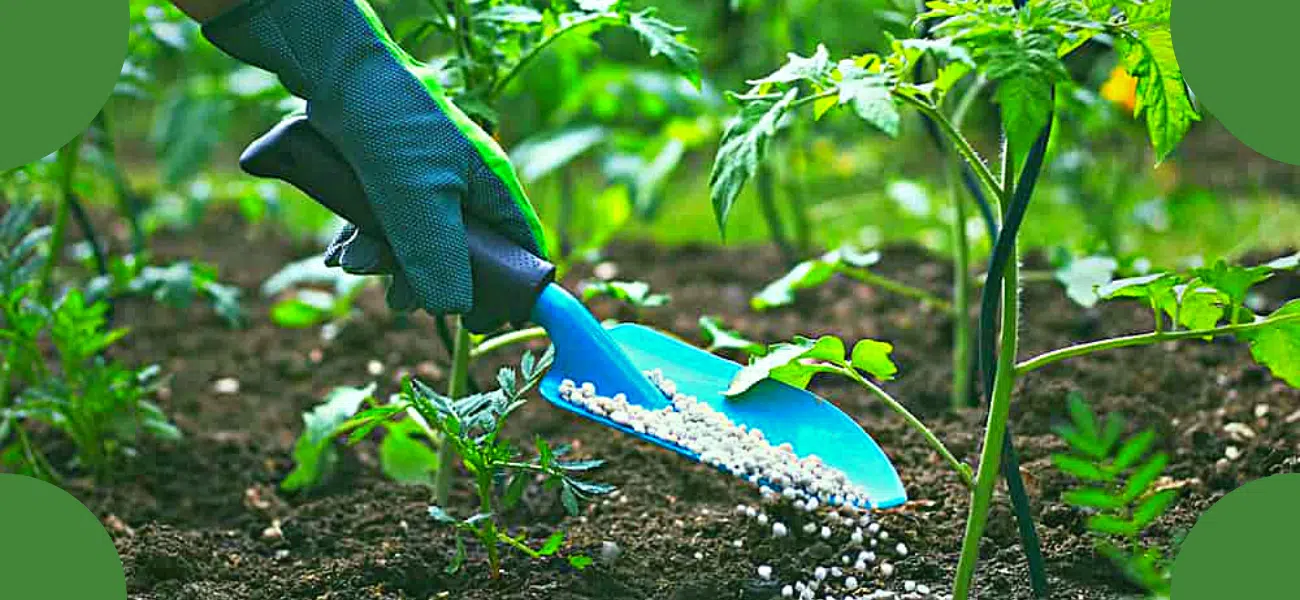Magnesium is one of the most vital nutrients present in your cannabis plant. If there is an issue with your weed plant’s magnesium, the plant will not thrive as well as you desire. Several things can go wrong when growing your weed plant, so it is vital to identify which nutrient is deficient in your weed plant and remedy the issue. Your plant will eventually wither and die with insufficient magnesium levels in your cannabis.

Contents
Why do cannabis plants require magnesium?
All cannabis plants require the nutrient magnesium because it is the nutrient that makes photosynthesis possible for the weed plant. When a magnesium deficit is present in a cannabis plant, you can expect the plant to lose many of its lower leaves. The deficiency will work its way up the plant until the cannabis plant is completely wilted. When a magnesium deficit is present in cannabis plants, the light will not absorb into the plant, which will eventually cause your plant to starve.
Cannabis relies on light absorption to continue to grow and thrive. Therefore, the amount of light you provide your weed plant is irrelevant when a magnesium deficit is present in your cannabis.

How to identify magnesium deficiency in cannabis plants?
The color and texture of the leaves will be a dead giveaway when your cannabis plant runs low on magnesium. The first leaves you need to check are the leaves on the bottom of your cannabis plant. These leaves are the first to lose magnesium because magnesium is a moveable nutrient. When magnesium levels are low, the magnesium will travel from the old leaves at the bottom of the plant to the newer leaves towards the top of the plant. Look at the leaves at the bottom of your plant and keep an eye out for a sickly yellowish hue or red stems.
This color will differ significantly from the color of the leaves at the top of your cannabis plant. When touched, magnesium deficient cannabis leaves will feel firm and brittle instead of lively and malleable. If you touch the leaves at the bottom of your weed plant and feel like they may snap or crunch, this can be a strong indicator that your cannabis is magnesium deficient.
If the magnesium deficiency travels too high up your weed plant, then your weed plant may wilt soon. Therefore, it is vital to keep an eye on the leaves at the bottom of your weed plant often to ensure that your plant thrives for as long as possible.

Differences between magnesium & calcium deficiencies?
Both magnesium and calcium are vital secondary nutrients that help cannabis plants grow and thrive. Both secondary nutrients are essential for a cannabis plant to experience successful photosynthesis. There are a few key differences in how calcium and magnesium deficiencies affect your cannabis plants. Magnesium deficiencies will initially take effect on the leaves at the base of the weed plant and work their way up.
However, when a calcium deficiency is present, the leaves at the top of the weed plant will be the first to show signs. New growth on a cannabis plant suffering from calcium deficiency will quickly twist off and become discolored.

For a magnesium deficiency, you will notice yellowish or bright green discoloration on the leaves at the base of the weed plant. However, with a calcium deficiency, you will see yellowish or purplish discoloration on the leaves at the top of the plant. The critical difference between the deficiencies is that a magnesium deficiency will affect the older leaves first, while a calcium deficiency will affect the new leaves first. Both deficiencies can eventually cause your plant to be wild and die when ignored.
Calcium deficiencies will also significantly affect how well your cannabis plant responds to heat. Weed plants that are low in calcium will have an extremely low tolerance for heat because calcium is the nutrient that provides cannabis plants with their heat regulation properties.
Why is magnesium deficiency bad for the cannabis plant?
A magnesium deficiency is bad for cannabis plants because, without enough magnesium, your cannabis plant won’t photosynthesize. Photosynthesis is how cannabis plants transfer the light it receives into energy to promote growth and stay alive. Photosynthesis provides energy to cannabis plants the same way that food gives us. When your weed plant cannot absorb light and transfer it into energy, your plant will starve and die.

You may not initially feel concerned when you notice that the leaves towards the bottom of your cannabis plant are discolored and brittle because those leaves are older. However, if the leaves at the bottom of your cannabis plants are discolored or brittle, this can indicate that the plant needs more magnesium. Eventually, the deficiency will work its way up the cannabis plant and cause the plant to die.
Magnesium is also an essential secondary nutrient that promotes the absorption of the primary nutrients your cannabis plant needs to thrive. Without nitrogen and phosphorus, your cannabis plant will not survive. Without magnesium, your cannabis plant will have trouble absorbing nitrogen and phosphorus. If your cannabis plant lacks critical nutrients, then your plant may wilt before it can ever flower.
Leading causes of magnesium deficiencies in cannabis plants?
The level of magnesium present in the soil of your cannabis plant will have a massive effect on the amount of magnesium present in your cannabis plant. Your soil can lose its magnesium if you water your weed plant too frequently. Overwatering is the most common reason people do not have enough magnesium in their cannabis plants, and it eventually leads to the death of the weed plant.

The substrate can also affect the magnesium level present in your weed plant. It is very acidic if your substrate is too low in PH level. Cannabis roots have a hard time absorbing substrate with too low a PH level. This means that even if there is enough magnesium present in the soil of your weed plant, your weed plant may have difficulty absorbing the nutrient through the roots.
Adding more magnesium to your substrate will not resolve your magnesium deficiency issue. It may seem like the answer to your problems, but it will worsen your nutrient deficiencies. Adding too much magnesium to your substrate will prevent your cannabis plant from absorbing the other vital nutrients it needs to survive.
How to prevent magnesium deficiency in weed plants?
The first thing you need to do to prevent your cannabis plant from having a magnesium deficiency is to make sure the soil you use for your cannabis plant is nutrient-rich. If your soil lacks any essential nutrients that your cannabis plant needs, then your weed plant will not have a way to absorb those nutrients. The ground you use will significantly affect whether your weed plant will receive enough magnesium or not.
The second thing you need to do to ensure your weed plant receives enough magnesium is to avoid overwatering your plant. When you water your cannabis plant too frequently, you risk washing away the nutrients present in your soil. If the magnesium in your soil washes away, there is no magnesium for your weed plant to absorb.
The third thing you need to do to prevent your cannabis plants from becoming magnesium deficient is flush the plants if you suspect a deficiency is developing. Stopping the problem before it develops into something more prominent is the best way to preserve the quality of your cannabis plants before they are compromised. Use PH water with added nutrients that your cannabis plant needs when flushing your plants.
The fourth thing you should do to prevent a magnesium deficiency in your cannabis plants is frequently check the PH of the water used to keep the plants hydrated. A magnesium deficiency is often present in plants that use water with too low a PH level. The water you use can severely affect your plant’s ability to absorb magnesium through the roots.
How to quickly fix cannabis magnesium deficiency?
The quickest way to resolve your magnesium deficiency is to fix all the possible contributors. To do this, you must flush out the system with water that is higher in PH and has the right amount of added cannabis nutrients. If you add too much of a single nutrient, your plant will lock out the other nutrients it needs to survive.
By flushing out your system, you also help treat other nutrient deficiencies. For example, most of the time, when you find a magnesium deficiency, you will also discover a calcium deficiency. Flushing the system with PH water helps treat both nutrient deficiencies simultaneously.
Frequently asked questions!
Best supplements for calcium & magnesium deficiencies?
Cal-Mag is the best supplement to aid your weed plant’s calcium and magnesium deficiency. Cal-Mag will adjust the PH of your water and add appropriate amounts of calcium and magnesium to your water without overdoing it. If you add too much of a single nutrient to your weed plant, you can lock out the other nutrients you need for your plant to survive.
Filtered water will not have enough magnesium on its own, and that is when it is in your best interest to use a supplement. This supplement will help ease the concern of adding the wrong PH or too much or little of a single nutrient to your cannabis plant.
How to fix magnesium deficiency in veg?
To fix a magnesium deficiency in veg, you need to flush the plant with PH and nutrient-rich water. The wrong PH in your water will cause your plant’s roots to have difficulty absorbing the nutrients it needs. So even if your soil has enough magnesium, the water can make it difficult for the plant to absorb it. Do not add too much magnesium to your plant even when it is deficient in the nutrient because this can cause the veg to lock out other nutrients it needs.
If your veg grows hydroponically, you need to check the PH of the water it grows in. You may need to adjust the PH and nutrient levels of your veg.
How to fix magnesium deficiency during flowering?
To fix a magnesium deficiency in your cannabis plant during its flowering stage, you can make a sprayable solution to flush out your plants without overwatering them. Mix Epsom salt, PH water, and calcium and spray on the roots of your plants once every three days. Any more than that will oversaturate your plants with water and nutrients and adversely affect your flowering process.
Once every three spray sessions, switch it up with regular water to prevent the flowers of the plants from witling. It is okay to get some on the flowering buds when using regular water.
Early cal-mag deficiency symptoms
For a magnesium deficiency, the first thing you will notice is brittle yellowish leaves at the base of your weed plant. This is because magnesium deficiencies will affect the older leaves n the plant before the newer leaves are affected. For a calcium deficiency, you can expect the leaves towards the top of the weed plant to twist off or become yellowish, purplish color.
When your cannabis plant is deficient in both nutrients, both areas of the weed plant will show symptoms. Both the older and newer leaves on your weed plant will be discolored and brittle to the touch when the plant is deficient in both nutrients.
Cal-mag deficiency with led lights?
A cal-mag deficiency is common in cannabis plants grown under LED lighting. Some LED grow lights do not provide an appropriate spectrum of light for the cannabis plant to grow. This is especially common in cheaper grow lights on the market. If your weed plant does not have enough energy to absorb the nutrients it needs, it will develop a calcium and magnesium deficiency.
Weed plants get energy from photosynthesis, and if there is not enough light spectrum to photosynthesize, the plant will run low on calcium and magnesium. Therefore, make sure your LED lights provide the entire light spectrum your cannabis plant needs to grow.



